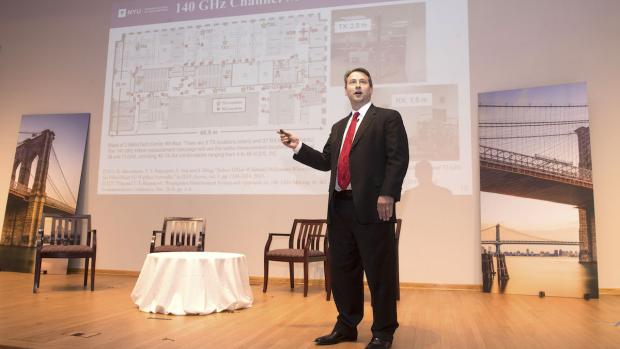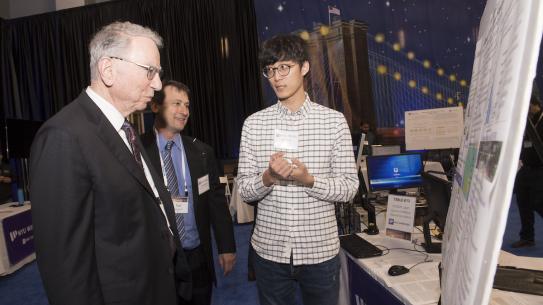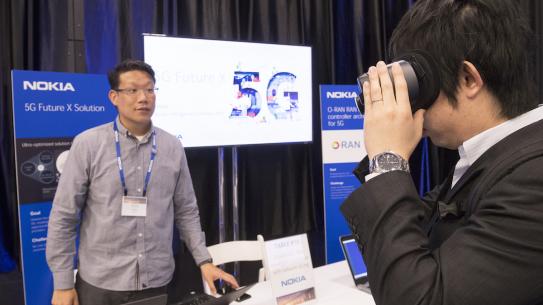5G shares the stage with 6G at the sixth annual Brooklyn 5G Summit

Professor Ted Rappaport, founding director of NYU WIRELESS and one of the pioneers of millimeter wave spectrum for wireless, addresses the standing-room-only crowd at the Brooklyn 5G Summit hosted at NYU Tandon.
The next generation of mobile telecommunications devices, networks, and services are rolling out in markets worldwide this year, but at the sixth annual Brooklyn 5G Summit (B5GS), topics involved both what’s on tap this year in markets in the U.S. and around the world, but also what’s happening next: 6G.
Hosted at NYU Tandon in Brooklyn by NYU WIRELESS and Nokia, the summit brought in record attendance and featured leaders from the major carriers and device makers, including Nokia, AT&T, Ericsson, and Sprint; as well as Federal Communications Commission’s (FCC) Michael O’Rielly, and top researchers from NYU Tandon and other institutions.
Topics presented at the event, held from April 23 – 25 (live-streamed by IEEE ComSoc), ranged from wireless spectrum allocation and “new radio” telecommunications standards from the industry standards group 3GPP, to massive MIMO antenna technologies, the virtues of machine learning in wireless network deployment, the current state of the 5G rollout, and much more.
Ted Rappaport, founding director of NYU WIRELESS and one of the pioneers of millimeter wave spectrum for wireless, invited the standing-room-only audience in the Pfizer auditorium to imagine the possibilities of the sub-terahertz spectrum starting at 95 GHz, and the futuristic 6G applications that it supports. Terahertz waves can carry tremendous amounts of data at short distances, which means they hold value not just for future applications, but for 5G where current spectrum can’t deliver high enough data or low enough latency. But Rappaport went even further, mulling the possibilities of 7G, predicting a science fiction future in which terahertz and new technology could bring high-end smartphones with the computational power of the human brain.
After a spirited introduction by Rappaport and Marcus Weldon, corporate chief technology officer (CTO) at Nokia and president of Nokia Bell Labs, the company’s CEO Rajeev Suri spoke via live video feed from Helsinki, Finland. Suri helped set the tone for the summit with the message that 5G “has been released to the wild,” and offered a rundown on how such tech as cloud edge-computing, network slicing, and smart sensors will drive 5G, making possible improvements in medicine and public safety.
Arun Ghosh, director of AT&T's Advanced Wireless Technology Group, discussed future systems in which base stations could are much more malleable and able to define regions flexibly.
And during a keynote address on Wednesday, Sprint CTO John Saw extolled the virtues of Massive MIMO and Band 41 5G New Radio (NR) — new radio access technology developed by the 3GPP standards body for 5G mobile — pointing out that these technologies could allow a carrier to cover all 50 stories of a hotel in Manhattan with one antenna. “You cannot do that with a legacy antenna,” he explained. He said that Sprint’s proposed merger with T-Mobile will be boon for both companies as it brings greater bandwidth to bear. “Together we can build a bigger and much better 5G network than each of us can build on our own,” he said.
During the final session on Thursday, NYU Tandon Professor Giuseppe Loianno joined Google Loon’s Sal Candido and Volker Ziegler of Nokia for a panel discussion about the use of aerial drones and balloons for commercial mobile phone and Internet service.
Other B5GS highlights:
- AT&T CTO Andre Fuetsch said the company will have 5G in 19 cities, and that its network carries more than 253 Terabytes of data every day. The growth area is video, now 57% of its traffic, which will grow given AT&T’s acquisition of Time Warner.
- Stanford University professor Andrea Goldsmith and Virginia Tech Professor Tim O’Shea explored how machine learning can be used to create channel models, which is especially important to characterizing millimeter wave transmissions. O’Shea said using machine learning can be time-, power-, and cost-efficient because software, not hardware, can do much of the signal processing.
- O'Rielly spoke of the need for the FCC to release more spectrum to 5G wireless carriers in the mid-band spectrum (2-8 Ghz).
- At the annual B5GS dinner at the National Academy of Sciences, Dr. Irwin Jacob, co-founder of Qualcomm, received the Wireless Pioneer Award and joined Rappaport for a “fireside chat” style interview.
The summit was not all talks and Powerpoints. While an agenda packed with presentations, keynotes and and panels played out over two days in the Pfizer auditorium, the gym in Rogers Hall featured an extensive floor show featuring technology from Nokia, NYU WIRELESS, Blue Danube, National Instruments, InterDigital and more. As Rappaport said in his IEEE.tv video coverage of the exhibition space, “It’s like the Mobile World Congress here at NYU Tandon.”







